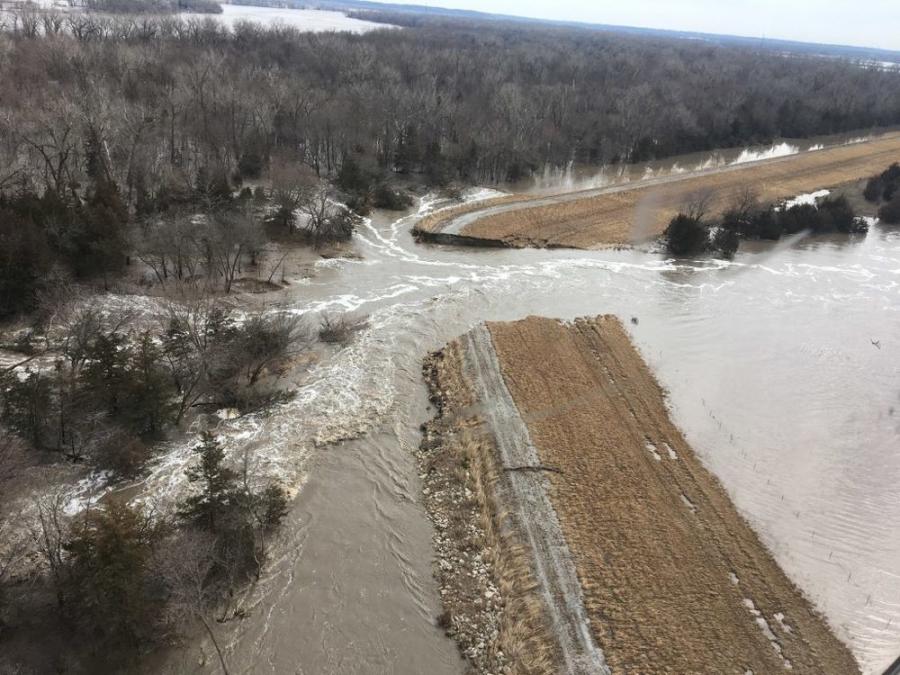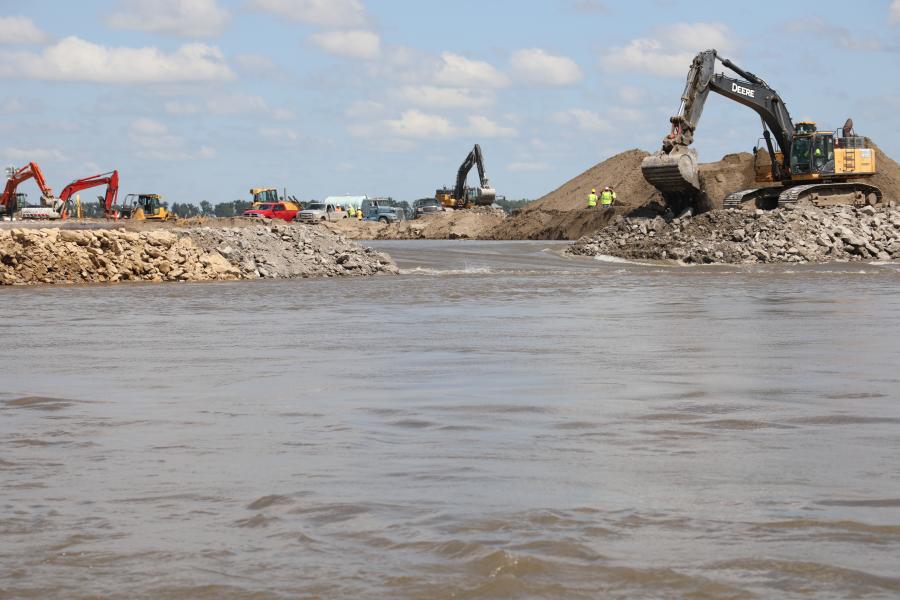There are more than 500 miles of levees on the Missouri, Platte and Elkhorn rivers, and tributaries that have experienced significant flood damage since March 2019.
(U.S. Army Corps of Engineers photo)
When the unprecedented and historical flooding started in the Missouri and Platte River basins in March 2019, the U.S. Army Corps of Engineers (USACE) Omaha District responded immediately. Within hours, the District, led by the Readiness Branch, was developing plans and sending materials out to fight the flood and provide assistance to communities within harm's way.
From aerial and onsite surveillance, it quickly became apparent that the flooding in 2019 was going to be far more significant than anyone had predicted, and in response, the USACE Omaha Systems Restoration Team (OSRT) was stood up.
"The team quickly realized how significant the March ‘Bomb Cyclone' was going to be across the Omaha District's Area of Responsibility. The Omaha Systems Restoration Team was committed to responding as quickly as possible, as we saw how this event was going to impact our friends, neighbors, communities, and even some of the families of District employees," said Bret Budd, chief of the Omaha Systems Restoration Team.
2019 Flooding at a Glance
In 2018, the Missouri River saw 165 percent of the average runoff in the basin, coupled with above average fall rain and winter snow throughout the lower part of the basin. Then in March 2019, on top of the saturated ground, widespread rainfall totals of 1 to 3 in. were observed across the region with pockets receiving up to 4 in. in eastern Nebraska and southeastern South Dakota.
As a result, approximately 45 river gauges on the Missouri River and its tributaries throughout the states of Iowa, Missouri, Nebraska and South Dakota set new stage records. Only amplifying matters was the fact that nearly all of these new stage records were on stretches of river downstream of Gavins Point Dam, the most downstream dam on the Missouri River, meaning that all of this water would flow throughout the basin without the ability for anyone to regulate the flows.
However, the March event was not the only one during 2019. In late-May and early-June, the basin saw another high-water event that sent river levels back up and jeopardized the repairs that the team had been able to put in place following the March event. Then again in mid-September, the basin saw another extreme event that would set more river gauge records across the lower Missouri River Basin.
This event dumped nearly 6 in. of rain across some areas in eastern South Dakota —causing the already swollen James and Sioux Rivers to reach historical levels and setting river level records at more than 15 different gauges throughout the area.
"We saw an unprecedented amount of runoff throughout the Missouri River Basin below Gavins Point Dam, which led to the Missouri River being in flood stage for nearly nine months. With these flows coming into the Missouri River below Gavins Point there was no way to regulate the flows on the Missouri River," explained Curtis Miller, Omaha District Senior Hydraulic Engineer. "This meant that it was more important than ever to be in continual coordination with the National Weather Service to have up-to-date forecasting information during our recovery planning efforts."
These significant events also were coupled with the overall extremely wet year experienced in the lower Missouri River Basin. It wasn't until Oct. 16 that the Omaha area saw five consecutive days without precipitation in 2019. This combination of extreme events and persistent precipitation have attributed to the Missouri River seeing almost 2.5 times the average runoff at the Sioux City, Iowa, river gauge — the second highest run-off year on record at this location.
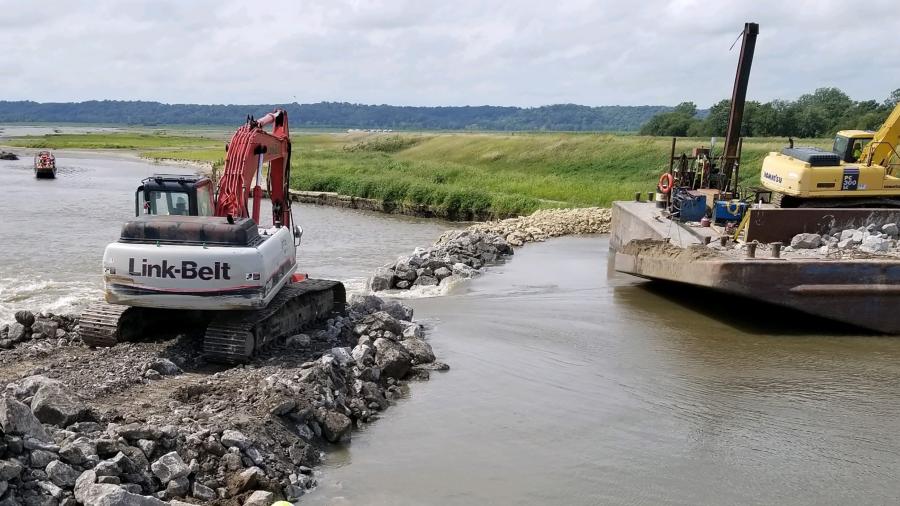
However, with the substantial amount of runoff seen in 2019 flowing into the Missouri River below (south) of Sioux City, Iowa, the river gauge at this location doesn't tell the whole story of the 2019 flood. To see the rest of the story one only has to look at the Missouri River gauge downstream at Nebraska City, Neb., which has been at or above flood stage for 270 consecutive days. This is more than three months longer than what was recorded at the same gauge during 2011 flooding and over 10 times longer than the 1993 flood event, demonstrating just how much more water has flowed through the lower Missouri River basin than what was experienced during the previous floods.
All told, more than 500 mi. of flood risk management infrastructure along 60 different levee and channel systems active in the USACE Public Law (PL) 84-99 Program and across five states in the Omaha District's Area of Responsibility (AOR) were damaged during the 2019 flood events. The PL 84-99 program allows levee sponsors, who operated and maintained their levees according to USACE standards, to be eligible to have flood damaged infrastructure repaired. Damages to PL 84-99 levees within the Omaha District area of responsibility included more than 50 breaches, some as large as 2000 ft. in length, with a staggering total repair estimate of over $1 billion.
Repairs, Then and Now
Within days of the March 2019 event, the Omaha District had awarded construction contracts to construct emergency breach closure repairs. The first two repair contracts were for breaches along the Platte River near Ashland, Neb., — as flows receded quickly enough to get to the breach locations with traditional construction equipment and the repairs were constructed within a week at both locations. The team had concurrently been working on identifying the highest risk breaches along the Missouri River and began trying to figure out how to close these priority breaches (i.e., breaches impacting Interstate 29) to stop the flow of water through the damaged levee systems.
Unlike the initial repairs along the Platte River, the repairs along the Missouri River would require innovative and adaptive construction methods, as the water levels had not, and would not, recede to allow access for traditional construction equipment to get to some of the damage locations. One solution that the Omaha District was able to come up with, through collaboration with the construction industry and the Missouri River Recovery Program (MRRP), was the use of dredges to take sediment from the river and floodplain MRRP sites and place it into the breach locations.
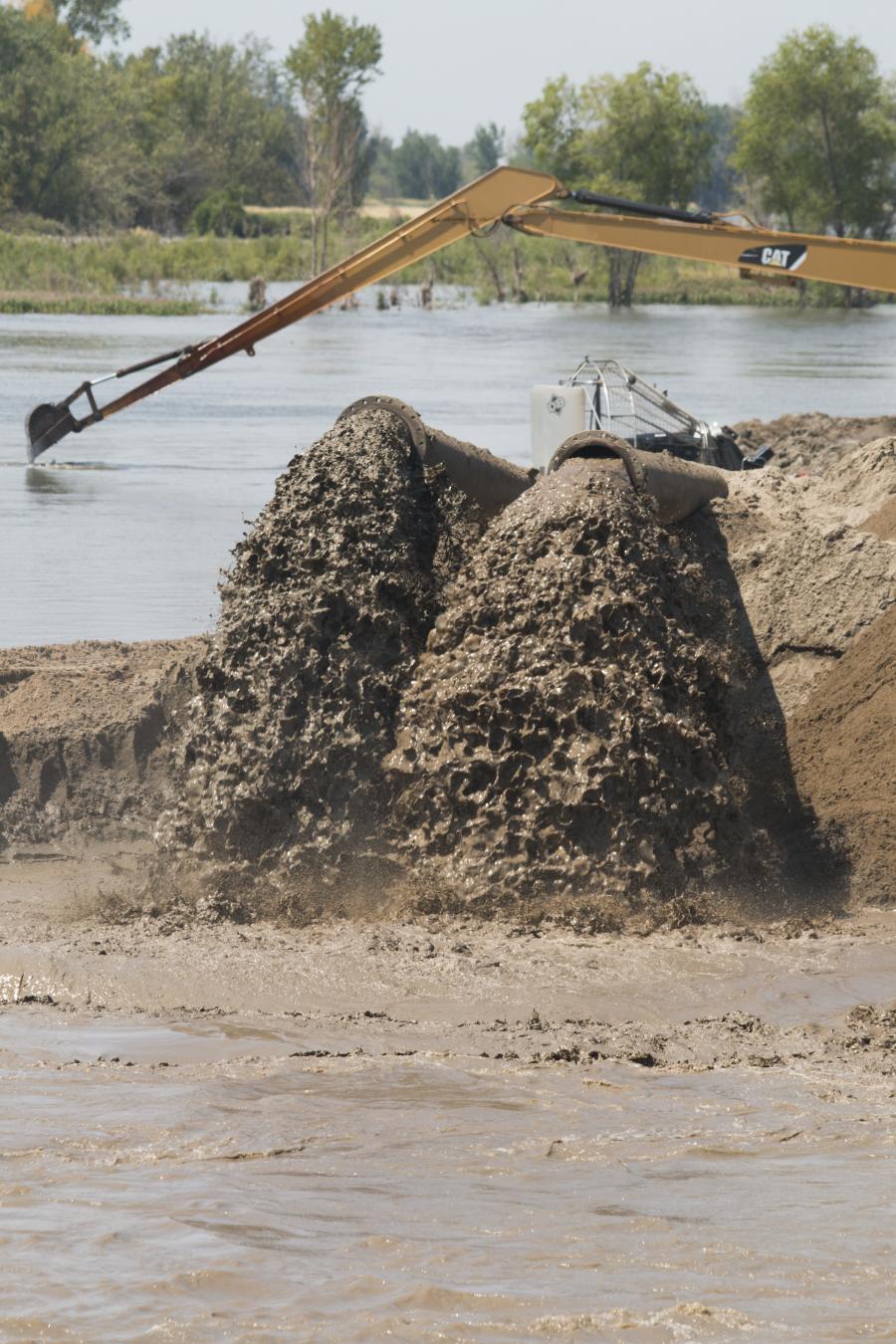
For the next couple of months the team would work hand-in-hand with construction contractors from across the nation to iteratively develop a process for utilizing dredging equipment for filling breaches that were currently flowing with water. This was the first time the District had ever been challenged to conduct repairs of this magnitude during active flooding and high water, but through a string of set-backs and even more successes, the team was able to close the inlet breaches, locations where water was flowing through the damaged levee system from the Missouri River, along the L-575 Missouri River Levee System.
The majority of the material dredged for the L-575 initial breach closures came from floodplain wildlife management areas (WMA) owned by the Omaha District under the MRRP. These borrow areas would eventually be converted to floodplain pool habitat features, resulting in a unique "win-win" opportunity between habitat restoration efforts and levee rehabilitation.
"The devastation to the levees and the infrastructure behind the levees was, and continues to be, immense. As we mobilized dredges and an army of large mechanical equipment to begin closing the inlet breaches, we were faced with a tremendous task of corralling the flow of the Missouri River while in flood stage," said Brendan Kight, area engineer of the Omaha District's Flood Recovery Construction Office. "Throughout the spring and summer, the Omaha District and our contractor partners battled the flooded Missouri River in an effort to close the inlet breaches and restore a level of protection to the critical infrastructure behind the levees.
"Construction techniques such as hydraulic dredging and mechanical sand placement were used to combat the swiftly flowing waters of the Missouri River passing through the inlet breaches. The team worked seven days a week all spring, summer and fall in an attempt to overcome the substantial flows and close the inlet breaches," added Kight. "The efforts put forth to close the inlet breaches was an incredible display of ingenuity and determination. Closure of inlet breaches such as those on the L-611-614, L-575, and L-550 Missouri River Levee Systems, among others, is a feat that should not be overlooked."
It was during this time that the OSRT also was stood up by Omaha District Commander Col. John Hudson to support the District's emergency management team. More than 100 employees throughout the District, as well as many others from other USACE offices across the nation, would be reassigned from their projects and positions to provide full-time support to the flood recovery efforts.
"Individual USACE Districts are not staffed to support events of the magnitude of the 2019 flooding. However, the USACE enterprise as a whole has a proven history of leveraging USACE experts from across the nation to respond to natural disasters," said Lowell Blankers, Omaha District Levee Safety Program manager. "The USACE response to the 2019 flooding across the Missouri River Basin was a testament to this ability, whether it was coordination with the Saint Louis and Kansas City Districts to get barges and dredges upstream so recovery efforts could continue or partnering with the USACE Risk Management Center, Portland District or Walla-Walla Districts to ensure all of the PL 84-99 rehabilitation efforts would continue forward."
The first priorities of the OSRT were to continue emergency breach repairs at the priority locations as well as to complete Project Information Reports (PIRs) for all of the damaged levee systems. PIRs are documentation the District is required to complete in order to receive approval and funding to repair levee systems under the PL 84-99 Authority and typically contain damage information collected during "on the ground" site inspections by USACE engineers. Because site access along many of the Missouri River levees was nearly impossible due to high flows, damage information was in the form of aerial imagery collected by USACE engineers via airplane and helicopter reconnaissance.
Over the next couple of months, the OSRT and Emergency Management team would be simultaneously awarding construction contracts for initial breach repairs along the Missouri River while also developing long-term repair strategies for all of the damaged levee systems, both along the Missouri River and across the tributaries. These strategies required the team to call on the vast experience throughout the District's Construction and Contracting teams to develop original contracting processes, such as the development of a pre-qualified sources list that would utilize a previously vetted list of contractors to cut the traditional contracting timeline in half to allow the District to get contractors on site to perform repairs as quickly as possible.
Beyond these original processes, the team also decided to use flexible construction contracting vehicles such as cost-reimbursable contracts. This would allow the District to get construction contractors on site to begin making repairs while the Engineering team continued to develop the design repairs, as many of the damage locations were still partially or fully submerged in flood waters. Using this cost-reimbursable strategy versus the more standard design-bid-build process allowed for faster and more efficient contracts to begin repairing the damaged infrastructure while flooding was still occurring.
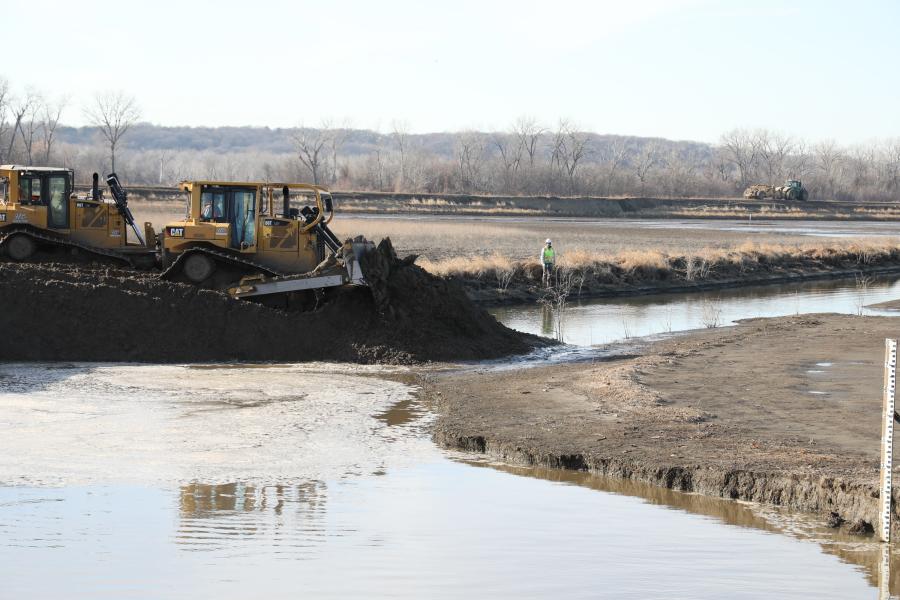
"Within the Omaha District's Contracting Division a new section was formed specifically to handle design and construction contracts associated with the 2019 flood recovery. This small group of approximately five personnel have worked tirelessly to ensure that these contracts are advertised and awarded as seamlessly and quickly as possible," said Lee McCormick, contracting officer and contracting team lead, Omaha Systems Restoration Team. "The contracting process has been reduced from approximately 70 days to 35 days, while still ensuring qualified contractors are selected."
To date, the District has invested more than 100,000 labor hours, roughly equivalent to the amount of hours a person would work for their entire career from age 18 to retirement, including more than 20,000 hours of overtime on weekends and holidays in response to the 2019 flooding. During this time, 18 levee breaches have been repaired, allowing for thousands of acres of land behind levee systems to drain out, and four levee systems along tributary systems in Nebraska and Iowa have been fully repaired to their originally authorized levels.
To conduct these and future repairs, the District has received more than $400 million, while at the same time putting in place a new construction contracting capacity of an additional $2 billion to sustain on-going flood response efforts.
The Omaha District could not accomplish what it has without the support it has received from impacted communities and stakeholders throughout this process. While homes, businesses, properties and livelihoods were, and still are, being impacted by the 2019 flooding, stakeholders have continued to come to the table to collaborate on solutions for restoring the damaged levees. Continual coordination with Iowa's Department of Transportation (DOT) has helped to ensure alignment between the District's repairs, and Iowa DOT's efforts to restore the damaged I-29 corridor. The Iowa Department of Natural Resources and Natural Resources Conservation Service have partnered with the Omaha District to provide a significant amount of clay material for levee repairs from state WMAs, resulting in the creation of wetland habitat that can be enjoyed by hunters and nature enthusiasts. Levee sponsors and stakeholders have committed tirelessly to meeting and strategizing with Omaha District teams, often requiring that they reschedule other commitments. Support from these groups and others has been instrumental in the success the District has been able to see so far.
"As we worked together to address infrastructure repairs, the Corps of Engineers and the Iowa DOT developed a very collaborative partnership. This collaboration was built through regular communication, site visits, in-person meetings, and frequent conference calls," said Charlie Purcell, Iowa Department of Transportation's project delivery division director.
"Although there were many projects we worked on together, one that stands out is the construction of new overflow bridges near the existing Iowa 2 crossing of the Missouri River. This unique project progressed from a very preliminary concept to a completed east bound structure and levee setback in just eight months," he said. "Normally a project of this scope would take two or three years to develop, and another year to construct. Without the extraordinary effort and cooperation of the Corps of Engineers, this project would still be on the drawing board instead of meeting the needs of the region for increased resiliency, both for the levee system and the roadway system. We are extremely proud of our joint effort on this project, which is truly a remarkable accomplishment."
The Road Ahead
While the OSRT has made significant progress since March, there is still much work to be done to restore the damaged flood risk management infrastructure. The team currently is working the development of multiple follow-on contracts for the Missouri River Levee Systems to continue interim and final repairs using the newly secured $2 billion contract capacity. As a parallel effort, the District also is continuing to develop design and repair contracts for the remaining damaged infrastructure along the tributary systems with the goal of having the tributary system repairs under contract before summer of 2020.
"The team continues to look for ways to reduce the overall 2019 flood response timeline, as we know how important these repair efforts are to communities across our area of responsibility. We also continue to have our eyes on the future to ensure that we are protecting our ongoing repair efforts from any future high-water events. Our hope is that by summer of 2020 we will be putting the finishing touches on many of the remaining levee repair efforts," said Trish Lambert, deputy chief of the Omaha Systems Restoration Team.
The timeline for repairs to the Missouri River Levee Systems isn't as well defined. This is due to the higher level of complexity of repairs along the mainstem, and water levels are not projected to recede far enough to see the full extent of the damages to the levee systems until the end of the 2019 calendar year. What is certain is that repairing these damaged levee systems will remain a top priority for the Omaha District, and the team will continue to adapt to the ever-changing challenges that are present when trying to repair damaged infrastructure during an on-going flood.
The other uncertainty that could affect 2019 flood repair efforts is what the upcoming winter and spring will hold in terms of precipitation and run-off. The team, led by Omaha District Construction offices on the ground, are devoted to keeping the repair efforts on-going as long as possible into the winter season. But there may be periods that efforts will have to be put on hold due to inclement weather that is often experienced during Midwest winters. Likewise, the team is prepared to adjust strategies as required in response to spring run-off to protect the previously completed repairs.
"It has really been a team effort out here on the levee systems. We can't say enough about the support of the levee sponsors and stakeholders," Dustin Davis, resident engineer of the Omaha District's Flood Recovery Construction Office. "For example, more than 70 percent of the equipment operators on one of our Missouri River Levee repair contracts were local farmers and landowners. I believe this really shows how focused everyone is on making sure these levees are restored as fast as possible."
Response to the 2019 flooding, as well as any future flooding that may occur during the on-going repair efforts, has been and will continue to be a priority for the Omaha District. The team is positioned and prepared to continue to work long hours to reduce the flood risk to friends, family and neighbors located within the Missouri River Basin as quickly and efficiently as possible.
There are more than 500 miles of levees on the Missouri, Platte and Elkhorn rivers, and tributaries that have experienced significant flood damage since March 2019. Due to the magnitude of damage along these levees, repair of the levee system efforts will take an extended period of time to execute.
Omaha District's focus remains on ensuring the safety of citizens and communicating the conditions on the river systems to all of our partners and stakeholders. The Corps continues to provide flood fight assistance to state, local and tribal government agencies.
For more information, visit www.nwo.usace.army.mil/Omaha-District-System-Restoration-Team/.
Today's top stories



